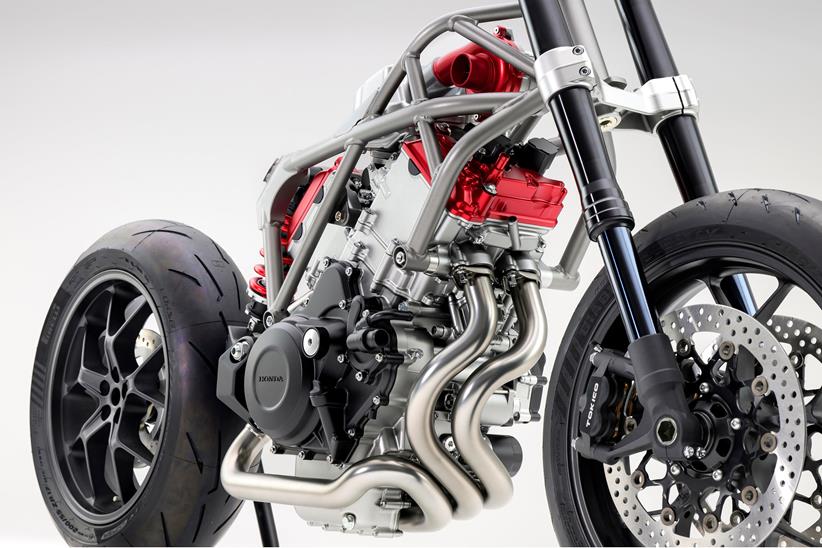
Updated: Yesterday 2:04 PM

Honda V3 engine in rolling chassis three-quarters close-up
6
In an effort to future-proof their internal combustion engines (ICE), Honda have unveiled an all-new ultra-efficient, medium-capacity forced induction V3 engine for their upcoming bike models, which could make its way to a production machine as soon as 2026.
While the Japanese brand has shown a firm commitment to the electric Kool-Aid – who recently showed off their EV Fun and EV Urban concepts at EICMA – the brand’s engineers have also been busy thinking about what the next generation ICE could look like.
What they have come up with is a 75-degree water-cooled three-cylinder unit, arranged in a V configuration with an electric compressor delivering compressed intake air – a first in the world of motorcycling.
![]()
Honda says the engine layout offers a particularly sleek and compact design, with the front cylinder bank containing two pots and a single cylinder at the rear.
While still in the development stages, the engine is running and has been on public display, housed in a steel trellis frame, with an accompanying single-sided swingarm and a pair of 17-inch wheels.
Honda is keeping tight-lipped on the details, with no engine displacement or power figures available, but MCN was able to sit down with the company’s Italian communications director Costantino Paolacci, who said:
![]()
“We are very proud of it, especially from a technical point of view. It’s important to say that it’s a real engine; it’s not a mock-up. The engine is already running on a bench. Next year we could potentially see a full prototype motorcycle with this, and the year after that we could see the first production model arrive.
“For us, the switch to forced induction is primarily about performance, not emissions. The compressor is intended to provide the torque of a larger engine with a smaller displacement.
“It will become the basis for a series of new models, the first of which will probably be a roadster,” Paolacci said.
![]()
Honda’s newly developed concept uses an electric motor to spin a turbine, increasing air density for combustion. It is in fact a supercharger, but not a supercharger driven by the engine’s crankshaft, as is usually the case.
Unlike turbochargers, which are driven by exhaust gases to deliver a pressurized volume of air, superchargers receive power through other means, such as a belt drive, gear drive or, as is the case here, an electric motor.
Because the compressor is rotated via an electric motor, there is greater layout freedom compared to a crankshaft-driven supercharger. There is also no need for an intercooler, which further benefits the compactness of the design.
![]()
Technology has firmly established itself in the automotive world 2018 Audi SQ7 SUV it is the first production car with an electric supercharger that provides boost while the twin turbochargers spool up. Other automakers began to follow suit, dabbling in electronic forced compression in various guises.
Due to the high power consumption required to run such systems (Audi’s version required a 48 volt backbone to provide sufficient power to the fan), no manufacturers have yet been able to achieve such a feat for the two-wheeled world.
To get around the problem of running the compressor, Honda confirmed to MCN that future bikes with this motor would be equipped with two batteries and a boosted charging system, with one battery solely responsible for powering the electric motor used to spin the turbine.
![]()
This strange configuration isn’t Honda’s first foray into V3 design, and those with long memories will remember the last time Honda had a road-going V3 engine: the groundbreaking two-stroke NS400R of the mid-1980s.
Now, 40 years later, the new motorcycle concept is a world apart in terms of technology from the old smoker. In addition to the potential to offer high power relative to capacity, it could also deliver emissions gains and high fuel efficiency relative to its power.